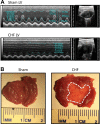Sympathoexcitation in response to cardiac and pulmonary afferent stimulation of TRPA1 channels is attenuated in rats with chronic heart failure
- PMID: 30707612
- PMCID: PMC6483016
- DOI: 10.1152/ajpheart.00696.2018
Sympathoexcitation in response to cardiac and pulmonary afferent stimulation of TRPA1 channels is attenuated in rats with chronic heart failure
Abstract
Excessive sympathoexcitation characterizes the chronic heart failure (CHF) state. An exaggerated cardiac sympathetic afferent reflex (CSAR) contributes to this sympathoexcitation. Prior studies have demonstrated that the CSAR to capsaicin [transient receptor potential (TRP) vanilloid 1 agonist] is exaggerated in CHF animal models. We recently discovered that capsaicin application to the lung visceral pleura in anesthetized, vagotomized, open-chested rats increases mean arterial pressure (MAP), heart rate (HR), and renal sympathetic nerve activity (RSNA). We named this response the pulmonary spinal afferent reflex (PSAR). Due to the similarities between TRP vanilloid 1 and TRP ankyrin 1 (TRPA1) channels as well as the excessive sympathoexcitation of CHF, we hypothesized that stimulation of the CSAR and PSAR with a specific TRPA1 agonist would result in an augmented response in CHF rats (coronary ligation model) compared with sham control rats. In response to a TRPA1 agonist, both CSAR and PSAR in sham rats resulted in biphasic changes in MAP and increases in HR and RSNA 10-12 wk postmyocardial infarction (post-MI). These effects were blunted in CHF rats. Assessment of TRPA1 expression levels in cardiopulmonary spinal afferents by immunofluorescence, quantitative RT-PCR, and Western blot analysis 10-12 wk post-MI all indicates reduced expression in CHF rats but no reduction at earlier time points. TRPA1 protein was reduced in a dorsal root ganglia cell culture model of inflammation and simulated tissue ischemia, raising the possibility that the in vivo reduction of TRPA1 expression was, in part, caused by CHF-related tissue ischemia and inflammation. These data provide evidence that reflex responses to cardiopulmonary spinal afferent TRPA1 stimulation may be attenuated in CHF rather than enhanced. NEW & NOTEWORTHY Excessive sympathoexcitation characterizes chronic heart failure (CHF). The contribution of transient receptor potential ankyrin 1 (TRPA1) channel-mediated reflexes to this sympathoexcitation is unknown. We found that application of TRPA1 agonist to the heart and lung surface resulted in increased heart rate and sympathetic output and a biphasic change in mean arterial pressure in control rats. These effects were attenuated in CHF rats, decreasing the likelihood that TRPA1 channels contribute to cardiopulmonary afferent sensitization in CHF.
Keywords: autonomic dysfunction; cardiovascular reflexes; heart failure; sensory afferents; sympathoexcitation.
Conflict of interest statement
No conflicts of interest, financial or otherwise, are declared by the authors.
Figures






References
-
- Barretto AC, Santos AC, Munhoz R, Rondon MU, Franco FG, Trombetta IC, Roveda F, de Matos LN, Braga AM, Middlekauff HR, Negrão CE. Increased muscle sympathetic nerve activity predicts mortality in heart failure patients. Int J Cardiol 135: 302–307, 2009. doi:10.1016/j.ijcard.2008.03.056. - DOI - PubMed
Publication types
MeSH terms
Substances
Grants and funding
LinkOut - more resources
Full Text Sources
Medical

